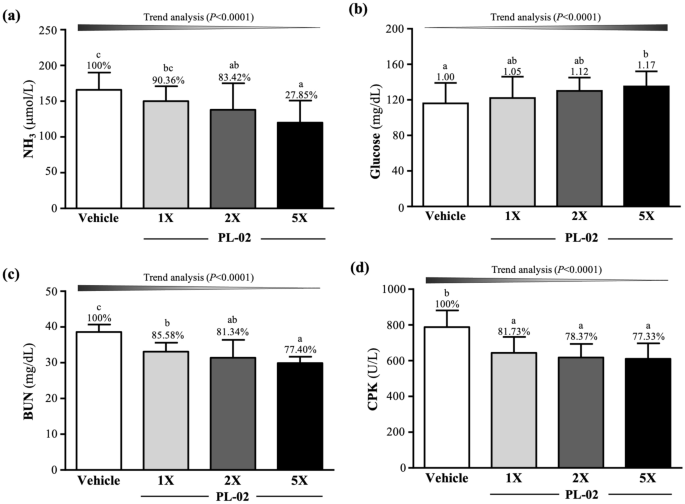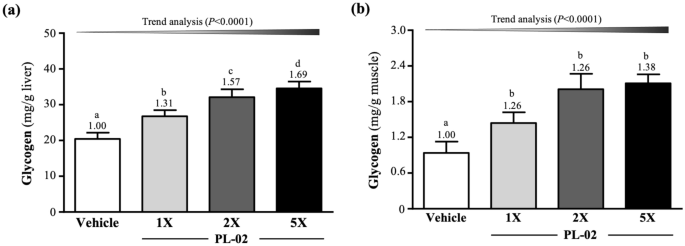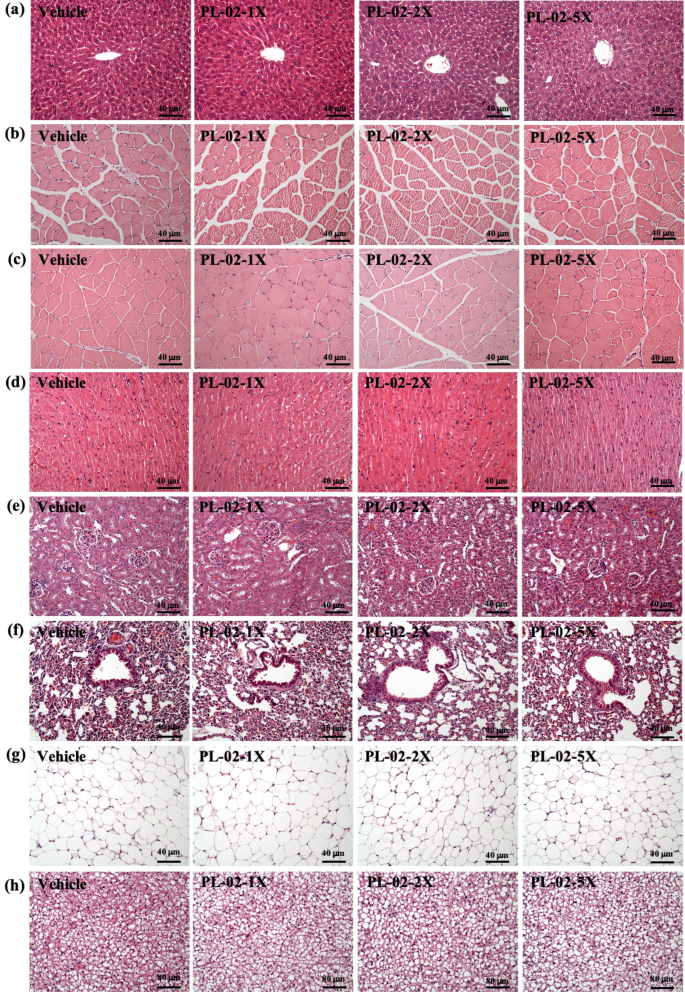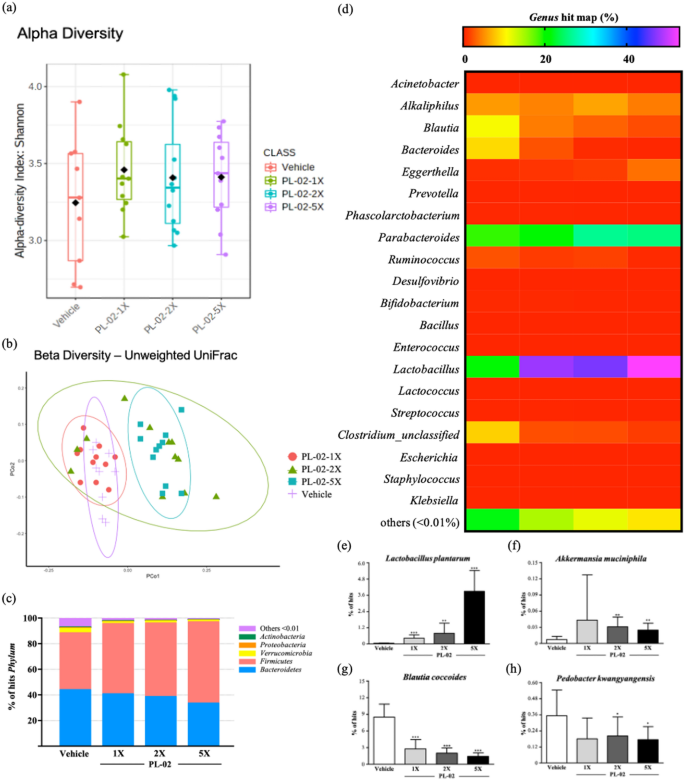General characteristics of mice with PL-02 supplementation for four weeks
As shown on Table 1, after four consecutive weeks of supplementation with PL-02, the weight of each group of mice showed stable growth; there was no significant difference between the groups, and there were no significant differences in the food intake and water intake of each group of mice. However, supplementation with PL-02 could effectively only improve skeletal muscle mass, which in the vehicle, PL-02-1X, PL-02-2X, and PL-02-5X groups was 0.37 ± 0.04, 0.39 ± 0.02, 0.40 ± 0.03, and 0.41 ± 0.02 (g), respectively. Compared with the placebo group, only the PL-02-5X group significantly increased by 1.10 -fold (p = 0.0028). But there is still a significant dose dependence, p = 0.0015. As the tissue weight is affected by the weight difference, we divided the tissue weight by the relative percentage of body weight and found that the relative skeletal muscles weight in the vehicle, PL-02-1X, PL-02-2X, and PL-02-5X groups was 1.00 ± 0.04, 1.05 ± 0.02, 1.06 ± 0.03, and 1.10 ± 0.02 (g), respectively. Compared with the placebo group, the PL-02-1X, PL-02-2X, and PL-02-5X groups were significantly increased relative skeletal muscles weight by 1.05 -fold (p = 0.0014), 1.06-fold (p = 0.0001), 1.11-fold (p < 0.0001), respectively. The effect of PL-02 supplementation on relative muscle weight was dose dependent (p < 0.0001).
Effect of PL-02 supplementation on exercise performance
On grip strength, after 4 weeks of PL-02 supplementation, the mean forelimb grip strengths of mice in the vehicle, PL-02-1X, PL-02-2X, and PL-02-5X groups were 126 ± 7, 141 ± 8, 147 ± 6, and 151 ± 6 g, respectively (Fig. 1a) The PL-02-1X, PL-02-2X, and PL-02-5X groups were significantly higher than the vehicle group by 1.11-fold (p < 0.0001), 1.16-fold (p < 0.0001), and 1.20-fold (p < 0.0001), respectively. Relative grip strength (%), normalized to body weight, was also significantly higher in groups with PL-02 supplementation (Fig. 1b). The effects of PL-02 supplementation on absolute and relative grip strength were dose dependent (p < 0.0001).
Effect of 4 weeks of PL-02 supplementation on (a) absolute forelimb grip strength, (b) forelimb grip strength (%) relative to body weight and (c) exhaustive swim time. Data are expressed as mean ± SD for n = 10 mice per group. Different superscript letters (a, b, c, d) indicate significant difference at p < 0.05.
After four weeks of PL-02 supplementation, the exhaustive swim times in the vehicle, PL-02-1X, PL-02-2X, and PL-02-5X groups were 6.81 ± 1.04, 8.16 ± 0.75, 9.74 ± 0.93, and 17.16 ± 1.53 min, respectively. The average exhaustive swim time of the PL-02-1X, PL-02-2X, and PL-02-5X groups was significantly increased by 1.20-fold (p = 0.0092), 1.43-fold (p < 0.0001), and 2.52-fold (p < 0.0001), respectively, as compared to the vehicle group. The trend analyses showed that the effect of PL-02 supplementation on maximum swim time was dose dependent (p < 0.0001) (Fig. 1c).
Effect of PL-02 supplementation on serum lactate levels after the 10-min swim test
After 4 weeks of supplementation with PL-02, all the mice were subjected to the 10-min swimming test to evaluate the levels of lactate (Table 2). Before swimming, there was no significant difference in blood lactate levels between groups. The serum lactate levels of mice in the vehicle, PL-02-1X, PL-02-2X, and PL-02-5X groups were 7.78 ± 0.70, 5.67 ± 0.78, 4.90 ± 0.55 and 4.65 ± 0.52 mmol/L after 10 min of swimming, respectively. Compared with the placebo group, the PL-02-1X, PL-02-2X, and PL-02-5X groups were significantly decreased by 27.16% (p < 0.0001), 37.05% (p < 0.0001), and 40.26% (p < 0.0001), respectively. Based on the serum lactate concentration before and after 10 min of swimming, the lactate production rates were determined to be 2.51 ± 0.22, 1.80 ± 0.08, 1.55 ± 0.09, and 1.46 ± 0.09, respectively, in the vehicle, PL-02-1X, PL-02-2X, and PL-02-5X groups. The PL-02-1X, PL-02-2X, and PL-02-5X groups were significantly lower than vehicle group by 27.99% % (p < 0.0001), 38.26% (p < 0.0001), and 41.74% (p < 0.0001), respectively.
After 20 min rest following the swimming test, the blood lactate levels in the vehicle, PL-02-1X, PL-02-2X, and PL-02-5X groups were 6.30 ± 0.56, 4.58 ± 0.54, 3.87 ± 0.42, and 3.46 ± 0.34 mmol/L, respectively. This represented a decrease of 27.35% (p = 0.0002), 38.61% (p < 0.0001), and 45.12% (p < 0.0001) in the PL-02-1X, PL-02-2X, and PL-02-5X groups, respectively, compared to the vehicle group. The clearance rate is used to understand the recovery effect of lactate after 10 min of exercise then 20 min of rest, which was determined to be 0.19 ± 0.04, 0.19 ± 0.04, 0.21 ± 0.04, and 0.25 ± 0.03, respectively, in the vehicle, PL-02-1X, PL-02-2X, and PL-02-5X groups. Compared with the placebo group, only the PL-02-5X group significantly increased by 1.34 -fold (p = 0.0003). The effect of PL-02 supplementation on serum lactate levels was also dose dependent.
Effect of PL-02 supplementation on fatigue-related biochemical parameters after the 10-min swim test or a 90 min swim test and 60 min rest
As shown in Fig. 2a, after the 10 min swim test, the serum ammonia levels in the vehicle, PL-02-1X, PL-02-2X, and PL-02-5X groups were 166 ± 24, 150 ± 21, 138 ± 37, and 120 ± 31 µmol/L, respectively. Compared with vehicle group, PL-02-2X and PL-02-5X groups were significantly decreased by 16.58% (p = 0.0423) and 27.85% (p = 0.0011). The glucose levels in the vehicle, PL-02-1X, PL-02-2X, and PL-02-5X groups were 116 ± 23, 122 ± 23, 130 ± 15, and 135 ± 17 mg/dL. Only PL-02-5X group was significantly greater than vehicle group by 1.17 -fold (p = 0.0368) (Fig. 2b). Supplementation with PL-02 could decrease ammonia and improve glucose levels after exercise, both of which have a dose-dependent effect (p < 0.0001).
The serum BUN levels were measured 60 min after the 90-min swimming test (Fig. 2c), which were found to be 38.6 ± 2.1, 33.1 ± 2.5, 31.4 ± 5.0, and 29.9 ± 1.8 mg/dL in the mice in the vehicle, PL-02-1X, PL-02-2X, and PL-02-5X groups, respectively. Compared with the vehicle group, the PL-02-1X, PL-02-2X, and PL-02-5X groups were significantly decreased by 14.42% (p = 0.0003), 18.66% (p < 0.0001), and 22.60% (p < 0.0001). The effect of PL-02 supplementation on serum BUN levels was also dose dependent (p < 0.0001). An exercise injury index, CK, had a significant difference among the groups after the 90 min swim test and 60 min rest (Fig. 2d). Compared with the vehicle group, the PL-02-1X, PL-02-2X, and PL-02-5X groups were significantly decreased by 18.27% (p = 0.0007), 21.63% (p < 0.0001), and 22.67% (p < 0.0001). The effect of PL-02 supplementation on serum CK levels was also dose dependent (p < 0.0001).
Effect of PL-02 Supplementation on liver and muscle glycogen
The liver glycogen levels of the mice in the vehicle, PL-02-1X, PL-02-2X, and PL-02-5X groups were 20.44 ± 1.75, 26.75 ± 1.73, 32.09 ± 2.24 m and 34.58 ± 1.88 mg/g liver, respectively (Fig. 3a). Compared with the vehicle group, the PL-02-1X, PL-02-2X, and PL-02-5X groups were significantly improved by 1.31 -fold (p < 0.0001), 1.57 -fold (p < 0.0001), and 1.69 -fold (p < 0.0001), respectively. Muscle glycogen levels in the vehicle, PL-02-1X, PL-02-2X, and PL-02-5X groups were 0.94 ± 0.19, 1.44 ± 0.18, 2.01 ± 0.26 m and 2.11 ± 0.15 mg/g muscle, respectively (Fig. 3b). The PL-02-1X, PL-02-2X, and PL-02-5X groups were significantly increased by 1.53-fold (p < 0.0001), 2.14-fold (p < 0.0001), and 2.24-fold (p < 0.0001), respectively, as compared to the vehicle group. The effect of PL-02 supplementation on liver and muscle glycogen content was also dose dependent (p < 0.0001).
Effect of PL-02 supplementation on biochemical profiles at the end of the study
We assessed whether supplementation of PL-02 for four weeks had an impact on the health and safety and conducted biochemical parameter tests (Table 3). As a result, all biochemical parameters were within the normal range. In addition, there were no significant differences between the groups. Therefore, we believe that supplementation with the doses with PL-02 will not cause any damage.
Effect of PL-02 supplementation on tissue histology
At the end of the study, we performed a histological evaluation of the liver, muscle, heart, kidney, lung, EFP, and BAT of the mice. As shown in Fig. 4, no abnormalities were observed in all groups. These results indicate that at the doses tested in this study, PL-02 has no adverse effects on organs and tissues.
Effect of PL-02 Supplementation on gut microbiota
At the end of the experiment, we analyzed the composition of the gut microbiota of mice treated with vehicle or PL-02 through 16S rRNA and observed the great changes in microbial ecology after PL-02 treatment. PL-02 did not significantly change alpha diversity (Shannon Diversity) (Fig. 5a), but it could change beta diversity by using Unweighted UniFrac model, which produced significantly different clusters between vehicle control and others (1X, 2X, and 5X, p = 0.013, p = 0.009 and p < 0.001, respectively, PERMANOVA by Adonis). (Fig. 5b). As shown on Fig. 5c, with the increased of the dose of PL-02, the percentage of Firmicutes in the gut microbiota also increased significantly. Among them, we could clearly see from the heat map that compared with the vehicle group (Fig. 5d), supplementation with PL-02 could effectively increase the proportion of Lactobacillus in the gut microbiota. With the increase in the dose of PL-02 supplementation, the proportion of L. plantarum (Fig. 5e) in the gut microbiota increased significantly (p < 0.0001), and the abundance of the specific gravity of Akkermansia muciniphila (Fig. 5f) also increased significantly (p < 0.01). In particular, the human harmful gut microbiota, Blautia coccoides (Fig. 5g) and Pedobacter kwangyangensis (Fig. 5h), were significantly lower in the PL-02-treated group than in the vehicle group, and the percentage of hits were inversely proportional to dose increase (p < 0.05).
Effect of PL-02 supplementation on (a) alpha diversity, (b) beta diversity, (c) phylum, (d) genus, (e) Lactobacillus plantarum % hits, (f) Akkermansia muciniphila. % hits, (g) Blautia coccoides % hits, and (h) Pedobacter kwangyangensis % hits. Data are expressed as mean ± SD for n = 8 mice per group. Values with different superscript letters are significantly different at *p < 0.05; **p < 0.01; ***p < 0.0001.





